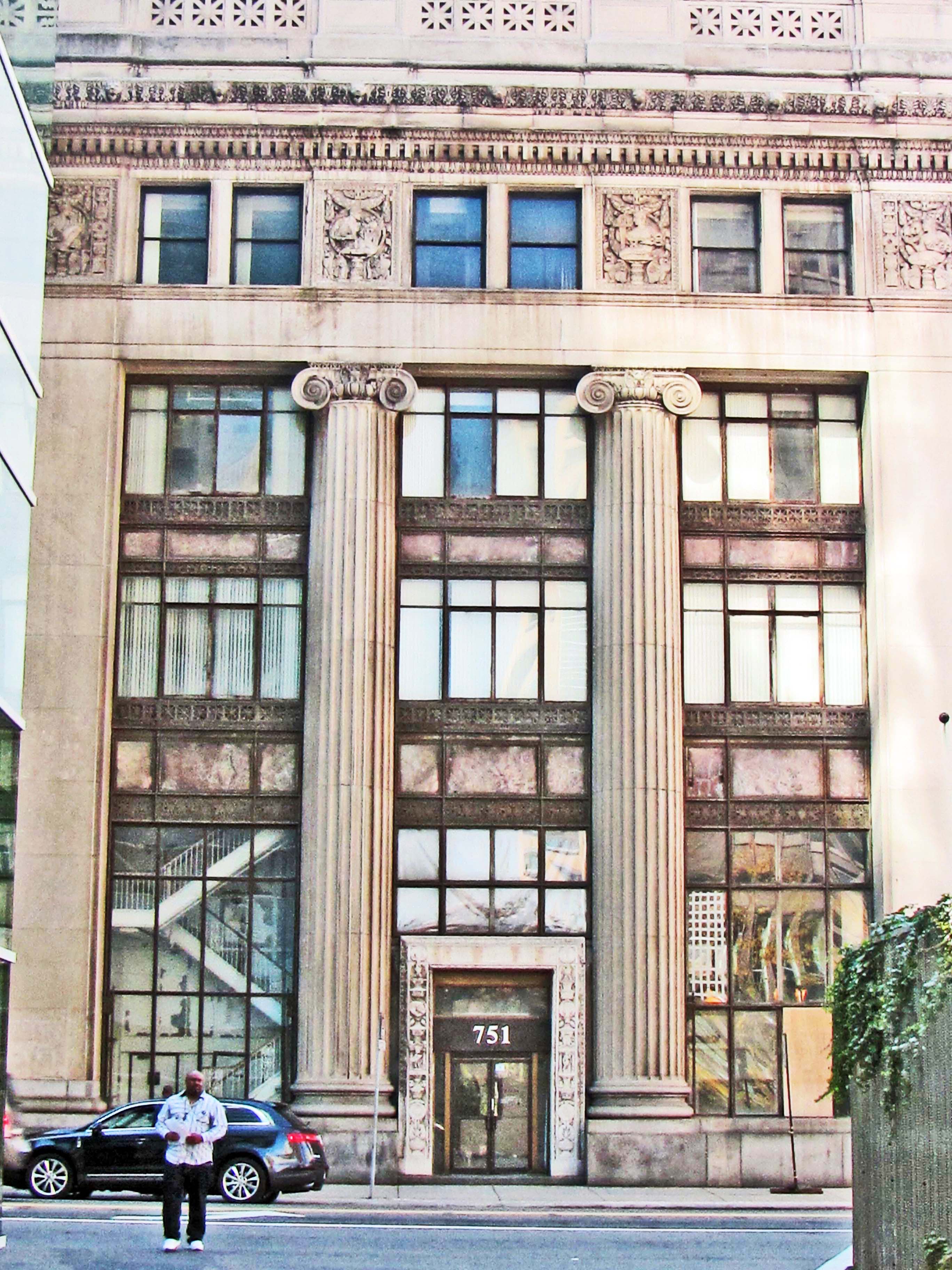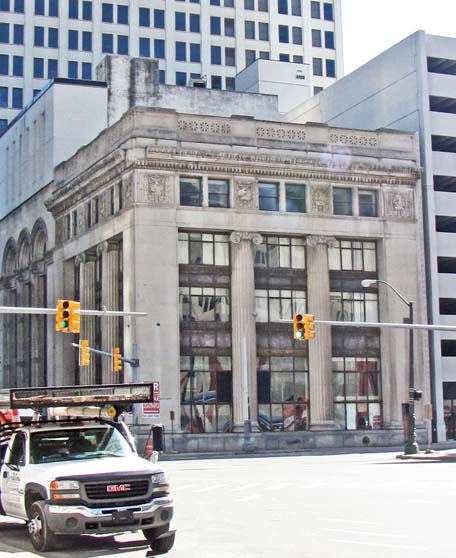

Albert Kahn did a marvelous job designing this impressive building. You observe that it is classical in style but very modern in that Kahn used glass extensively to let sunlight flow into offices and workshops. In the building you see, it is offices that gained Sol’s light. The classical design, however, is what is most impressive about this structure. There is a four-story frame here clad in limestone. At the roofline, you see a traditional parapet. Kahn added rich decorative features on both the Griswold and West Lafayette faces of this building. Presumably, the directors of this bank wished to convey a message about the security of funds deposited with them. And they selected the most accomplished Detroit architect to design their building. When it was built, laws prohibited branch banks, so all who did business with this bank had to visit this building.
I do not know much about the history of this bank. However, this fiscal institution played an important role—but quite indirectly—in the development of the Ford Motor Company that continues to sell vehicles today. John S. Gray was born in Edinburgh, Scotland in 1841. Those were challenging years in the Celtic lands so his father moved the entire family to Wisconsin in 1849, presumably in hopes of securing some economic success unattainable in Scotland. He found that success, but not in the farm fields of Wisconsin. Apparently, the elder Gray learned that he did not like farming or was unsuccessful in that profession so he moved his family to Detroit in 1858. Rather quickly, became an entrepreneur. First he ran a toy store in Detroit and then he joined with several partners to form a candy manufacturing firm. By the 1870s, the candy firm was flourishing. John S. Gray—the son born in Edinburgh—got his education in Detroit and taught school at several locations in Michigan as a young man. However, his father’s candy business grew so he returned to Detroit and joined his father’s firm. Eventually, the firm had a fiv- story plant and employed 200 while marketing its products throughout the nation. Alas, I do not know where the factory of the Gray, Toynton and Fox firm was located in Detroit.
John S. Gray became a prominent Detroit businessman and ran or owned several firms in the city. As was common for businessman in that late Nineteenth Century era, he also performed civic service and was a member of the city’s library board. By the end of the Nineteenth Century, although a Scotsmen, he was president of the German-American Bank, a direct ancestor of First State Bank whose building you see pictured here.
John S. Gray’s nephew was Alexander Y. Malcomson, a Detroit coal dealer who had known Henry Ford for many years. I believe they had both worked at the Detroit Engine Works on Atwater Street. Malcomson strongly believed that F ord would eventually be successful in the vehicle business. By 1900, Henry Ford was running the Henry Ford Company but the bankers who invested in that firm were very unhappy with him. By 1902, those investors brought in Henry Leland to look over the business. Eventually the bankers forced Ford out of the company and then Leland created the Cadillac Motor Company from what had been Ford’s firm. In about 1902, Malcomson and Henry Ford formed a partnership to manufacturing cars. Lacking capital they had to buy component parts from suppliers, parts that Ford then assembled into cars. Very quickly Ford found himself owing a tremendous amount to the Dodge Brothers who supplied parts. He had no hope of paying those bills so the future of this firm looked bleak. Malcomson proposed that a corporation be created using $100,000 to be obtained from investors. It was not easy to find investors. Henry Ford did not have a great record as an entrepreneur. Malcomson convinced his uncle, John S. Gray, to put up $10,500 for a 10.5 percent share of the new Ford Motor Company. Gray agreed and, on July 16, 1903, legal papers were drawn up by Horace Rackham for the incorporation of the Ford Motor Company. This was accomplished in the offices of Malcomson’s coal firm then located where Hart Plaza is now located. A state of Michigan Historic Marker commemorates that site, not far from where Antoine Cadillac arrived two centuries previously. John S. Gray was elected president of the Ford Motor Company with Henry Ford serving as Vice-President.
ord would eventually be successful in the vehicle business. By 1900, Henry Ford was running the Henry Ford Company but the bankers who invested in that firm were very unhappy with him. By 1902, those investors brought in Henry Leland to look over the business. Eventually the bankers forced Ford out of the company and then Leland created the Cadillac Motor Company from what had been Ford’s firm. In about 1902, Malcomson and Henry Ford formed a partnership to manufacturing cars. Lacking capital they had to buy component parts from suppliers, parts that Ford then assembled into cars. Very quickly Ford found himself owing a tremendous amount to the Dodge Brothers who supplied parts. He had no hope of paying those bills so the future of this firm looked bleak. Malcomson proposed that a corporation be created using $100,000 to be obtained from investors. It was not easy to find investors. Henry Ford did not have a great record as an entrepreneur. Malcomson convinced his uncle, John S. Gray, to put up $10,500 for a 10.5 percent share of the new Ford Motor Company. Gray agreed and, on July 16, 1903, legal papers were drawn up by Horace Rackham for the incorporation of the Ford Motor Company. This was accomplished in the offices of Malcomson’s coal firm then located where Hart Plaza is now located. A state of Michigan Historic Marker commemorates that site, not far from where Antoine Cadillac arrived two centuries previously. John S. Gray was elected president of the Ford Motor Company with Henry Ford serving as Vice-President.
Difficulties arose almost immediately. Apparently several of the investors strongly disagreed with Henry Ford about how the firm should operate and how to maximize profits. After much bickering, John S. Gray sided with Henry Ford, and about 1905, Malcomson, was forced out as a director of the Ford Motor Company. Malcomson sold his Ford shares. Unfortunately, Gray—the president of Ford Motor Company—died of a heart issue shortly thereafter in 1906. Ford took over as president and remained in control for the rest of his long life. Gray’s estate held on to his shares—10.5 percent of the firm—until 1919 when Henry Ford bought them for 26.25 million. By that time, Gray’s estate had received more than ten million in dividends. That is, John S. Gray’s initial investment of $10,500 yielded a total of more than 36 million dollars
After being forced out of the Ford Motor Company, Malcomson held on to his high hopes for the vehicle industry and decided that he would start his own vehicle company. This was the Aerocar Company. Their original building that Malcomson constructed stands to this day at the corner of Mack and Beaufait. It is a great example of the first generation of vehicle factories that were erected in Detroit and other manufacturing centers before Albert Kahn’s structurally reinforced concrete became popular. Malcomson, however, did not share the good fate of Henry Ford. For the 1906 model year, Aerocar offered a five seat touring car powered by a 24 horsepower air-cooled engine and selling at $2800. By 1908, Aerocar was offering three models ranging in price from $1500 to $2200. However, that was the end of the line for Aerocar as production ceased in 1908. Malcomson sold his building to department store magnet Joseph Hudson who used it to produce the first Hudson automobiles. You can drive along Mack and see this interesting if rather undistinguished building in 2011. As you can judge, many Detroit entrepreneurs who had little background in manufacturing saw opportunities making cars in the early years of the 1900s and started their own companies. Unfortunately, most failed.
Despite the failure of his Autocar Company, Malcomson’s coal business and other investments prospered and, when he died in the 1920s, he was among the state’s financial elite.
I do not know when the German-American Bank became the First State Bank, nor do I know what happened to the First State Bank. You might speculate that First State Bank expired in the bank holiday in March of 1933 when most Michigan banks closed and that their assets, to the extent there were any, were taken over by some other bank or a newly created bank. The building pictured above has been for sale for quite a number of years. If there is a revitalization of Detroit’s financial district and a growth of activities in downtown to the west of Woodward, this building might provide an opportunity for a new entrepreneur.
Architect: Albert Kahn
Architectural style: Classical
Date of completion: 1925
Use in 2011: Vacant building awaiting redevelopment
City of Detroit Designated Historic District: Not listed
State of Michigan Registry of Historic Sites: Not listed
National Register of Historic Places: This building is a contributing structure to the
Detroit Financial Historic District that was listed on the National Register on December 14, 2009
Photograph: Ren Farley September 30, 2010
Description prepared: December, 2011
Return to Commercial Buildings
Return to Detroit Financial District